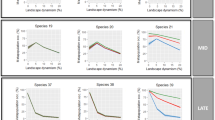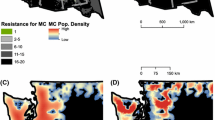Abstract
Although landscape ecology emphasizes the effects of spatial pattern on ecological processes, most neutral models of species–habitat relationships have treated habitat as a static constraint. Do the working hypotheses derived from these models extend to real landscapes where disturbances create a shifting mosaic? A spatial landscape simulator incorporating vegetation dynamics and a metapopulation model was used to compare species in static and dynamic landscapes with identical habitat amounts and spatial patterns. The main drivers of vegetation dynamics were stand-replacing disturbances, followed by gradual change from early-successional to old-growth habitats. Species dynamics were based on a simple occupancy model, with dispersal simulated as a random walk. As the proportion of available habitat (p) decreased from 1.0, species occupancy generally declined more rapidly and reached extinction at higher habitat levels in dynamic than in static landscapes. However, habitat occupancy was sometimes actually higher in dynamic landscapes than in static landscapes with similar habitat amounts and patterns. This effect was most pronounced at intermediate amounts of habitat (p = 0.3−0.6) for mobile species that had high colonization rates, but were unable to cross non-habitat patches. Differences between static and dynamic landscapes were contingent upon the initial metapopulation size and the shapes of disturbances and the resulting habitat patterns. Overall, the results demonstrate that dispersal-limited species exhibit more pronounced critical behavior in dynamic landscapes than is predicted by simple neutral models based on static landscapes. Thus, caution should be exercised in extending generalizations derived from static landscape models to disturbance-driven landscape mosaics.
Similar content being viewed by others
References
H.R. Akcakaya V.C. Radeloff D.J. Mlandenoff H.S. He (2004) ArticleTitleIntegrating landscape and metapopulation modeling approaches: viability of the sharp-tailed grouse in a dynamic landscape Conservation Biology 18 526–537 Occurrence Handle10.1111/j.1523-1739.2004.00520.x
V.J. Bakker D.H. Vuren ParticleVan (2004) ArticleTitleGap-crossing decisions by the red squirrel, a forest-dependent small mammal Conservation Biology 18 689–697 Occurrence Handle10.1111/j.1523-1739.2004.00149.x
J. Bascompte R.V. Sole (1996) ArticleTitleHabitat fragmentation and extinction thresholds in spatially explicit models Journal of Animal Ecology 65 465–473
D. Boughton U. Malvadkar (2002) ArticleTitleExtinction risk in successional landscapes subject to catastrophic disturbances Conservation Ecology 6 2
D. Boychuk A.H. Perera M.T. Ter-Mikaelian D.L. Martell C. Li (1997) ArticleTitleModelling the effect of spatial scale and correlated fire disturbances on forest age distribution Ecological Modelling 95 145–164 Occurrence Handle10.1016/S0304-3800(96)00042-7
T.M. Brooks S.L. Pimm J.O. Oyugi (1999) ArticleTitleTime lag between deforestation and bird extinction in tropical forest fragments Conservation Biology 13 1140–1150 Occurrence Handle10.1046/j.1523-1739.1999.98341.x
G. Cowlishaw (1999) ArticleTitlePredicting the pattern of decline of African primate diversity: an extinction debt from historical deforestation Conservation Biology 13 1183–1193 Occurrence Handle10.1046/j.1523-1739.1999.98433.x
A. Desrochers S.J. Hannon (1997) ArticleTitleGap crossing decisions by forest songbirds during the post-fledging period Conservation Biology 11 1204–1210 Occurrence Handle10.1046/j.1523-1739.1997.96187.x
L. Fahrig (1991) Simulation methods for developing general landscape-level hypotheses of single-species dynamics M.G. Turner R.H. Gardner (Eds) Quantitative Methods in Landscape Ecology Springer-Verlag New York 417–442
L. Fahrig (1998) ArticleTitleWhen does fragmentation of breeding habitat affect population survival? Ecological Modelling 105 273–292 Occurrence Handle10.1016/S0304-3800(97)00163-4
L. Fahrig (2002) ArticleTitleEffect of habitat fragmentation on the extinction threshold: a synthesis Ecological Applications 12 346–353
C.H. Flather M. Bevers (2002) ArticleTitlePatchy reaction-diffusion and population abundance: the relative importance of habitat amount and arrangement American Naturalist 159 40–56
R.H. Gardner B.T. Milne M.G. Turner R.V. O’Neill (1987) ArticleTitleNeutral models for the analysis of broad-scale landscape patterns Landscape Ecology 1 19–28 Occurrence Handle10.1007/BF02275262
R.H. Gardner M.G. Turner R.V. O’Neill S. Lavorel (1991) Simulation of the scale-dependent effects of landscape boundaries on species persistence and dispersal M.M. Holland P.G. Risser R.J. Naiman (Eds) Ecotones: The Role of Landscape Boundaries in the Management and Restoration of Changing Environments Chapman and Hall New York 76–89
E.M. Glenn M.C. Hansen R.G. Anthony (2004) ArticleTitleSpotted owl home-range and habitat use in young forests of western Oregon Journal of Wildlife Management 68 33–50 Occurrence Handle10.2193/0022-541X(2004)068[0033:SOHAHU]2.0.CO;2
W.D. Gu R. Heikkila I. Hanski (2002) ArticleTitleEstimating the consequences of habitat fragmentation on extinction risk in dynamic landscapes Landscape Ecology 17 699–710 Occurrence Handle10.1023/A:1022993317717
E.J. Gustafson R.H. Gardner (1996) ArticleTitleThe effect of landscape heterogeneity on the probability of patch colonization Ecology 77 94–107
I. Hanski (1999) ArticleTitleHabitat connectivity, habitat continuity, and metapopulations in dynamic landscapes Oikos 87 209–219
E.K. Heyerdahl L.B. Brubaker J.K. Agee (2001) ArticleTitleSpatial controls of historical fire regimes: a multiscale example from the interior westUSA Ecology 82 660–678
M.F. Hill H. Caswell (1999) ArticleTitleHabitat fragmentation and extinction thresholds on fractal landscapes Ecology Letters 2 121–127 Occurrence Handle10.1046/j.1461-0248.1999.22061.x
M.P. Johnson (2000) ArticleTitleThe influence of patch demographics on metapopulations, with particular reference to successional landscapes Oikos 88 67–74 Occurrence Handle10.1034/j.1600-0706.2000.880108.x
K. Johst R. Brandl S. Eber (2002) ArticleTitleMetapopulation persistence in dynamic landscapes: the role of dispersal distance Oikos 98 263–270 Occurrence Handle10.1034/j.1600-0706.2002.980208.x
T.H. Keitt D.L. Urban B.T. Milne (1997) ArticleTitleDetecting critical scales in fragmented landscapes Conservation Ecology 1 4
J.E. Keymer P.A. Marquet J.X. Velasco-Hernandez S.A. Levin (2000) ArticleTitleExtinction thresholds and metapopulation persistence in dynamic landscapes American Naturalist 156 478–494
G.R. Matlack J. Monde (2004) ArticleTitleConsequences of low mobility in spatially and temporally heterogeneous ecosystems Journal of Ecology 92 1025–1035 Occurrence Handle10.1111/j.0022-0477.2004.00908.x
K.A. Moloney S.A. Levin (1996) ArticleTitleThe effects of disturbance architecture on landscape-level population dynamics Ecology 77 375–394
S.T.A. Pickett P.S. White (1985) The Ecology of Natural Disturbance and Patch Dynamics Academic Press OrlandoFL
W.H. Richards D.O. Wallin N.H. Schumaker (2002) ArticleTitleAn analysis of late-seral forest connectivity in western Oregon, USA Conservation Biology 16 1409–1421 Occurrence Handle10.1046/j.1523-1739.2002.01433.x
N.H. Schumaker T. Ernst D. White J. Baker P. Haggerty (2004) ArticleTitleProjecting wildlife responses to alternative future landscapes in Oregon's Willamette Basin Ecological Applications 14 381–400
D. Tilman R.M. May C.L. Lehman M.A. Nowak (1994) ArticleTitleHabitat destruction and the extinction debt Nature 371 65–66
C.E. Wagner ParticleVan (1978) ArticleTitleAge-class distribution and forest fire cycle Canadian Journal of Forest Research 8 220–227
A.S. Watt (1947) ArticleTitlePattern and process in the plant community Journal of Ecology 35 1–22
M.C. Wimberly (2002) ArticleTitleSpatial simulation of historical landscape patterns in coastal forests of the Pacific Northwest Canadian Journal of Forest Research 32 1316–1328 Occurrence Handle10.1139/x02-054
M.C. Wimberly (2004) ArticleTitleFire and forest landscapes in the Georgia Piedmont: an assessment of spatial modeling assumptions Ecological Modelling 180 41–56 Occurrence Handle10.1016/j.ecolmodel.2003.11.020
M.C. Wimberly T.A. Spies (2001) ArticleTitleInfluences of environment and disturbance on forest patterns in coastal Oregon watersheds Ecology 82 1443–1459
K.A. With A.W. King (1999a) ArticleTitleDispersal success on fractal landscapes: a consequence of lacunarity thresholds Landscape Ecology 14 73–82 Occurrence Handle10.1023/A:1008030215600
K.A. With A.W. King (1999b) ArticleTitleExtinction thresholds for species in fractal landscapes Conservation Biology 13 314–326 Occurrence Handle10.1046/j.1523-1739.1999.013002314.x
J.G. Wu S.A. Levin (1994) ArticleTitleA spatial patch dynamic modeling approach to pattern and process in an annual grassland Ecological Monographs 64 447–464
J.G. Wu O.L. Loucks (1995) ArticleTitleFrom balance of nature to hierarchical patch dynamics: a paradigm shift in ecology Quarterly Review of Biology 70 439–466 Occurrence Handle10.1086/419172
Author information
Authors and Affiliations
Rights and permissions
About this article
Cite this article
Wimberly, M.C. Species Dynamics in Disturbed Landscapes: When does a Shifting Habitat Mosaic Enhance Connectivity?. Landscape Ecol 21, 35–46 (2006). https://doi.org/10.1007/s10980-005-7757-8
Received:
Accepted:
Issue Date:
DOI: https://doi.org/10.1007/s10980-005-7757-8




